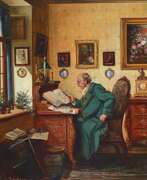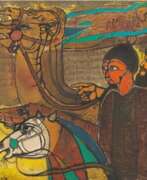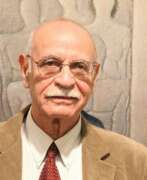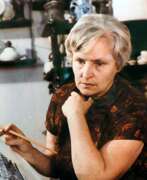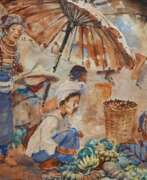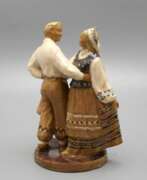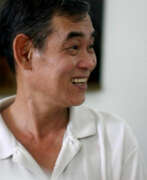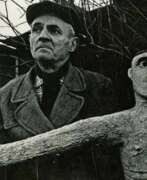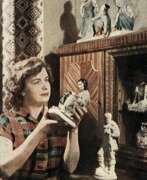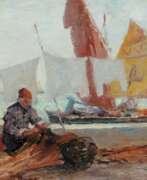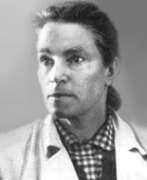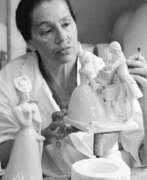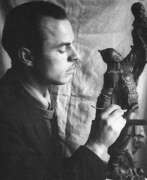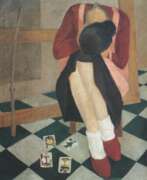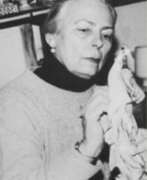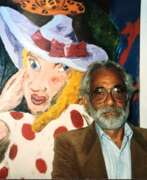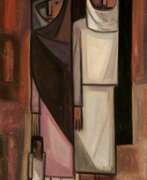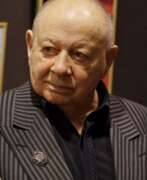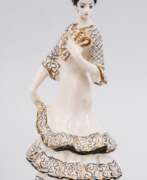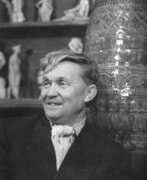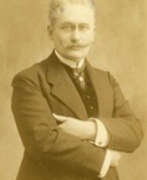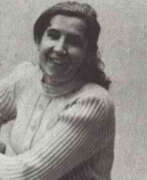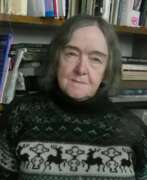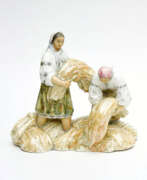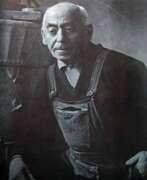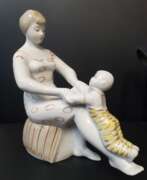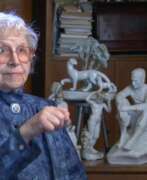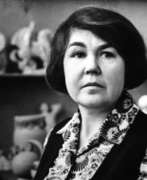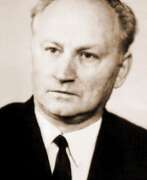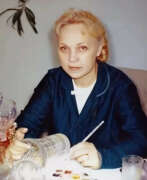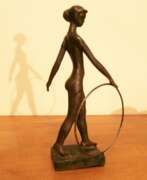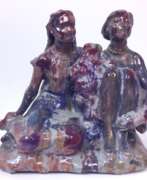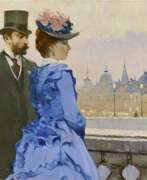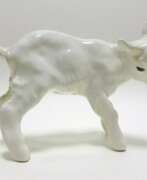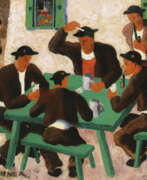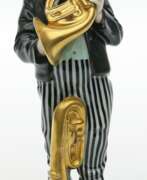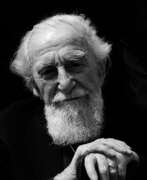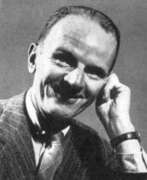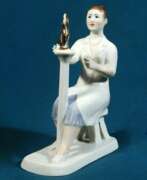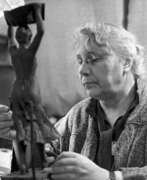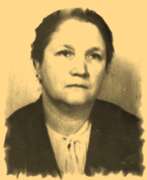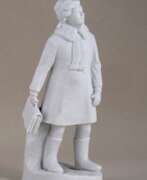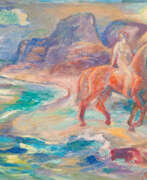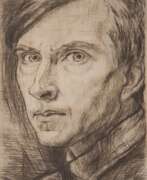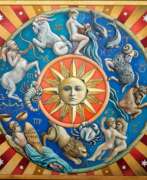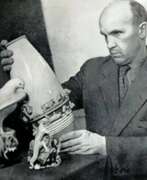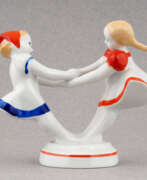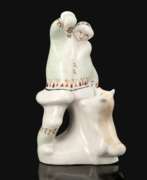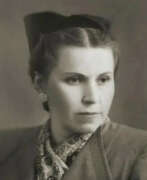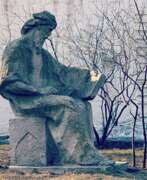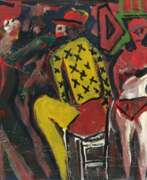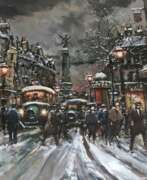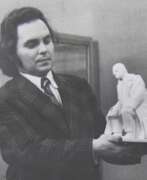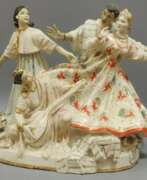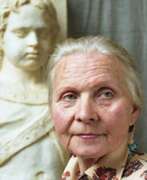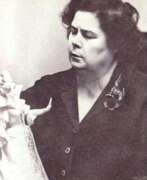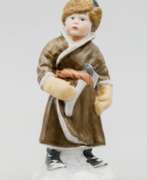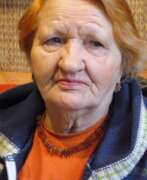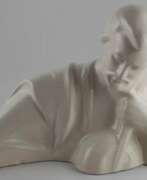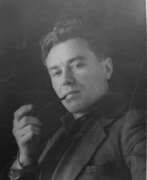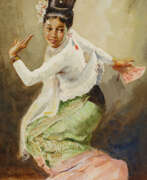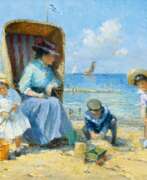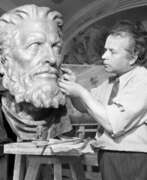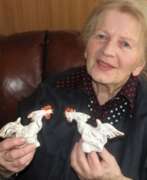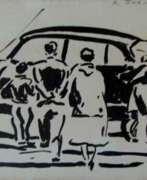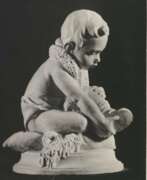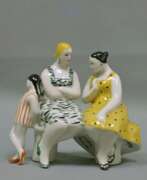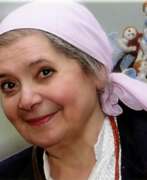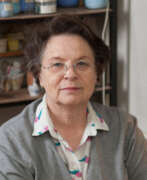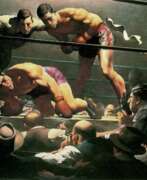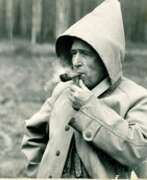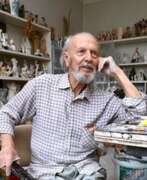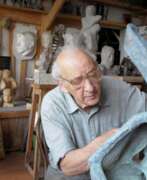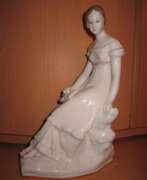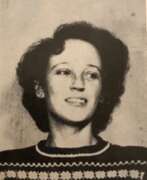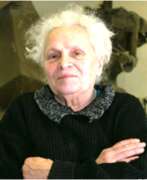Genre painters Post War Art
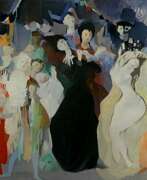

Karl Otto Bachmann, a Swiss painter, graphic artist, and illustrator, began his artistic career in Luzern before moving to Zurich and pursuing freelance work. He achieved a breakthrough in 1943 with the publication of his "Faust" portfolio. Bachmann drew inspiration from his travels across Europe, often joining circus troupes for income and creative ideas. His paintings were characterized by imaginative and virtual settings, with themes revolving around the stage, carnival, and circus. Bachmann's elegant lines, delicate colors, and harmonious compositions made him a respected book illustrator. He actively participated in numerous exhibitions throughout his life, both domestically and internationally.
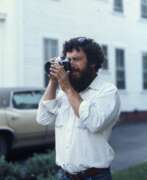

John Baeder is an American painter closely associated with the photorealist movement. He is best known for his detailed paintings of American roadside diners and eateries. His interest in small towns across America began when he was young by photographing old cars and other relics. He started working as an art director in Atlanta for a branch of a New York advertising agency in 1960, and subsequently moved to New York City in 1964. He went on to have a successful career in advertising through the early 1970s, while continuing to paint, draw and photograph on his own time. Baeder left the advertising field in 1972 to pursue his artistic career full-time. The same year, OK Harris Gallery in New York began exhibiting his artworks. Since then, he has had more than thirty solo exhibitions at art galleries. His work includes oil paintings, watercolors and photographs. Baeder’s work aims to chronicle the disappearing aspects of American culture. Baeder is the recipient of the Tennessee Governor's Distinguished Artist Award in 2009.


Yves Brayer was a French painter and lithographer known for his landscapes, portraits and still lifes.
Brayer studied at the École Nationale Supérieure des Beaux-Arts in Paris and then in Rome. He was influenced by classical art and inspired by Mediterranean landscapes, which he often depicted in his paintings. He was also interested in the culture of ancient Greece, which influenced his work.
Brye's early work was inspired by the Cubist and Surrealist movements. He was a founding member of the Paris School, a group of artists working in the French capital in the mid-twentieth century. He was also a member of the French Academy of Fine Arts and a Knight of the Legion of Honour.
Bryeux's work has been exhibited in prestigious galleries and museums around the world, including the Louvre in Paris, the Museum of Modern Art in New York and the National Museum of Western Art in Tokyo. His paintings are in many private collections.
Over the course of his career, Brye has received numerous awards and honours, including the Grand Prix de Rome and the Prix de l'Institut de France. He is considered one of the most important French artists of the 20th century.


Walter Einbeck was a German artist of the first half of the twentieth century. He is known as a painter and graphic artist, portraitist and genre painter.
Walter Einbeck studied at the Munich Academy of Fine Arts and the Weimar Art School, and participated in the First World War. After the war he developed an interest in theosophy, and in 1919 he settled in Munich, where he opened his own studio. In 1933, the artist joined the NSDAP. He became the author of the famous portrait of Deputy Führer Rudolf Hess, which was presented at the Great German Art Exhibition in 1939. In addition to portraits, the artist also created allegorical paintings, including in the nude genre.
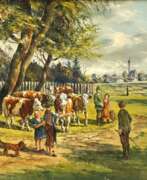

Alfred Fritzsching is a German artist known as Painter, graphic artist, draftsman, sculptor, commercial, commercial graphic artist. He began his training as a commercial graphic artist at the Blocherer School for Graphic and Advertising in Munich and worked as an advertising specialist. In 1970 Alfred Fritzsching became a member of Munich Artists 'cooperative and participated in exhibitions at the Haus der Kunst in Munich. From 1978, he worked as a freelance painter and also as board member and juror of the Munich Artists' Cooperative.
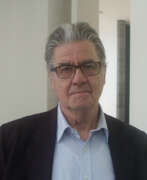

Franz Gertsch is one of Switzerland's most outstanding contemporary artists. Throughout his career, he has produced a wide range of paintings and graphic works in which he tries to find a particular approach to reality. Although the author uses photographs or slide projections as his starting points, the paintings adhere to a logic of their own which seeks the correctness of all elements. Woodcuts also occupy a special place in Franz Gertsch's work.
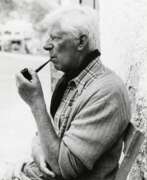

Werner Gilles was a German artist.
He was a member of the Bauhaus school of art and design. After arriving on the Italian island of Ischia in 1932, Gilles found inspiration for painting. In his oil paintings and watercolors, the artist depicts the cheerful and menacing aspects of this primitive landscape and captures its basic nature.


Max Gubler was a Swiss artist.
He experimented with various contemporary styles, until developing his own personal vivid style of landscape painting on Lipari. Later he turned to abstraction, but continued to use bright colours. In 1956 he did a series of pastel illustrations for Ernest Hemingway's The Old Man and the Sea. In his late works, darker colours predominate.
His work was shown in many galleries.


Haddad Maurice is a contemporary painter from South Iraq. Encountering the work of Haddad Maurice for the first time, one can not help noticing the diversity of his compositional approaches, his media and materials. There are water color paintings that at first sight seem almost conventional, but that bear witness to an awareness of country life, sharp observation, an ability to catch moods. The works showing Iraqi women, real beauties, one might say, are close to folk art: bright, colorful, geometrical, and basically well-balanced in their formal language that relies on curves, segments of circles intercutting each other. Some works are mythological both in their formal language and their historical reference. In the case of these works, often wood instead of canvas is used as a surface.


Robert Hammerstiel, an Austrian painter and engraver born on 18 February 1933 in Vršac, Yugoslavia, was renowned for his profound and impactful art. His works, deeply influenced by his experiences, were widely exhibited in prominent cities like New York, Vienna, Cairo, and Brussels.
Hammerstiel's journey in the art world was notable for its depth and variety. In 1988, he transitioned to a full-time artistic career, leaving behind his work in the steel industry. This shift marked a new phase in his life, allowing him to fully dedicate himself to his art. One of his significant works includes "Von Ikonen und Ratten: Eine Banater Kindheit 1939 – 1949," which comprises 32 woodcuts, highlighting his skill in both writing and visual arts. His talent was recognized with several prestigious honors, including the Austrian Decoration for Science and Art in 1998 and the Austrian State Prize for Graphics in 1973.
Hammerstiel's art was not just limited to traditional formats; in 2007, he impressively wrapped the Ringturm in Vienna with a 4,000 square meter painting. His works are a part of various collections and have been displayed in significant exhibitions. Notably, the Leopold Museum in Vienna featured his graphic work in an exhibition titled "Winterreise", inspired by Schubert's song cycle, showcasing a series of drawings and woodcuts.
Robert Hammerstiel's influence in the art world extended beyond his lifetime, culminating in his birth town dedicating a museum to his works in 2010. His passing on 23 November 2020 marked the end of an era but left behind a rich legacy that continues to inspire artists and art lovers globally. His work is a testament to the power of art in expressing the complexities of human experiences and emotions.
For collectors, auctioneers, and experts in art and antiques, the works of Robert Hammerstiel offer a unique blend of cultural richness and profound artistic expression. His art, characterized by its emotional depth and technical skill, continues to hold a special place in the world of fine arts.
To stay informed about exhibitions, sales, and auction events related to Robert Hammerstiel's art, sign up for updates. This subscription will keep you updated on new opportunities to engage with the work of this influential Austrian artist.


Albert Heinzinger, born in 1911 in Kempten im Allgäu, Germany, was an artist whose life and work were as compelling as his art. He began his career with an apprenticeship as a chemigrapher before studying graphic arts under Ludwig von Herterich in Munich. Heinzinger's journey as an artist took a more profound turn as he evolved into a painter and woodcutter.
His life was marked by significant challenges and political engagement. Heinzinger was a member of the Socialist Workers' Party and actively participated in resistance activities. This led to his imprisonment as a political prisoner in the Papenburger concentration camp Moor from 1938 to 1941. After his release, he resumed his artistic career in Munich from 1946.
Heinzinger's education continued under Professor Adolf Schinnerer at the Munich Academy from 1946-47. His artistic endeavors were enriched by study trips to various countries, including Italy, Yugoslavia, France, and England. He was a pivotal figure in the post-war art scene in Munich, contributing to the establishment of the "New Realism" art movement and being a founding member of the Association of Visual Artists in Munich.
Albert Heinzinger's artistic legacy is preserved through his works that have been auctioned. His dedication to painting and woodcutting, along with his significant contributions to political art and social commentary, make him an intriguing figure for collectors, auctioneers, and experts in art and antiques. Heinzinger's life story adds an enriching context to his artworks, which are not only visual treats but also historical narratives.
For those interested in learning more about Albert Heinzinger and keeping updated with related events and sales, it would be beneficial to sign up for newsletters and updates. This will ensure that they remain informed about the latest opportunities and developments related to Heinzinger's works.
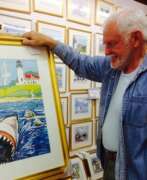

Robert Edward Kennedy, an American artist born in Boston, is renowned for his evocative paintings and illustrations. His journey in art began at the Rhode Island School of Design, where he honed his skills in painting and illustration. Kennedy's art is deeply influenced by his travels across the Caribbean, Mexico, and Florida, where he captured the essence of these locales in his sketchbook and watercolors. His work is more than just art; it serves as a historical record, showcasing the vibrant streets, waterfronts, and popular pubs of America's colorful areas.
Kennedy's art is characterized by its meticulous detail and classic style, combined with a heartwarming flair. This unique blend has earned him a place as one of America's top-selling artists. His popularity is a testament to his ability to connect with art enthusiasts worldwide. Kennedy's contributions to the art world extend beyond his paintings. In 1968, he and his brothers opened their first studio in a 19th-century stable on Beacon Hill, Boston. By the mid-1980s, Kennedy Studios had expanded to 37 locations, from Kennebunkport to Key West. Bob Kennedy's role in this expansion was crucial, as he provided numerous drawings and watercolors that represented iconic East Coast landmarks.
A notable innovation by Kennedy in the art world was his coining of the term "giclee" in 1995. This term was used to describe the advanced inkjet fine art reproduction technique, a significant step forward from the traditional offset lithography of the time. This innovation reflects Kennedy's forward-thinking approach and his contributions to modernizing art reproduction techniques.
Among Kennedy's well-known works are his watercolor prints, such as "Make Way For Ducklings" and "Provincetown Sail." These pieces have been sought after in the art market, showcasing his skill in capturing the essence of American landscapes and scenes.
For collectors, auctioneers, and art and antiques experts, Kennedy's work represents a blend of traditional artistry with modern innovation. His paintings and prints are more than just visual experiences; they are journeys into the heart of American culture and history.
For those interested in the dynamic world of Robert Edward Kennedy's art, we invite you to sign up for updates. By subscribing, you'll be the first to know about new product sales and auction events related to Kennedy's work. Stay connected with us and don't miss out on the opportunity to explore and acquire pieces from one of America's most celebrated artists.
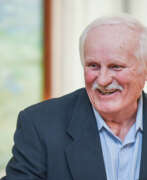

Robert Efimovich Landarsky (Russian: Роберт Ефимович Ландарский) is a contemporary Belarusian artist. He is known as a painter working in easel painting in the genre of landscape and figurative painting.
Robert Landarsky is the author of many works with views of picturesque corners of Belarus, as well as paintings on the theme of rural life, which the artist, who grew up in the countryside, knows well. The master of many works devoted to the heroism of people during the war, his brush also belongs to a triptych dedicated to the tragedy of Chernobyl. In the paintings of the artist dominate bright colors, noticeable influence on his work of the Impressionists.
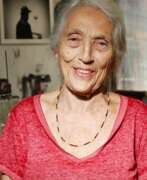

June Leaf is an American artist known for her abstract allegorical paintings and drawings; she also works in modernist kinetic sculpture. Her work is included in many permanent art collections including, the Smithsonian American Art Museum, the Art Institute of Chicago, Museum of Contemporary Art Chicago, Museum of Modern Art (MoMA), Minneapolis Institute of Art.
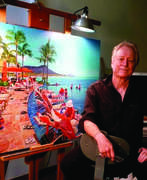

Jack Mendenhall is a California-based painter, whose interest in printed advertising imagery led to his inclusion in the Photorealist movement. In his early years, Mendenhall created paintings of curated luxurious home interiors, which he used as a subtle societal critique. His later paintings evolved to include optimistic depictions of exotic resorts that feature pools, palm trees and relaxation. Mendenhall’s prolific career spans over 50 years. His work is in the collections of the University of California, Berkeley and the Oakland Museum.
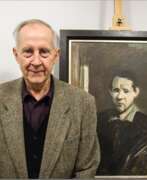

Harald Metzkes is a German painter and graphic artist.
In 1976 he won the Käthe Kollwitz Prize from the Arts Academy of East Germany and state-level official recognition in the form of the Banner of Labor. The next year his work was the focus of an exhibition at the National Gallery in (East) Berlin, "Harald Metzkes – Two decades of Pictures". 1976 was also the year in which he was a recipient of the National Prize of East Germany for illustrations and graphic art. In 1984 and 1988 Metzkes participated in the Venice Biennale.
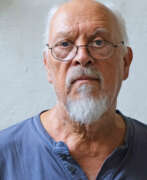

Karl Ulrich Nuss is a German artist and sculptor who creates large-scale bronze compositions.
His father was the sculptor Fritz Nuss (1907-1999), Karl Ulrich Nuss continued his work and developed an unmistakable design style that characterizes all his sculptures. They depict single people, couples, families, as well as new fantastical creations from the animal kingdom. These works can be seen in public spaces in Bochum, Frankfurt/Main and Stuttgart.
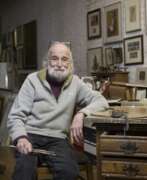

Burton Silverman, born in 1928 in New York City, is a distinguished American realist painter whose career spans over seven decades. His profound commitment to capturing the human condition has solidified his reputation as a leading figure in contemporary realism.
Early Life and Education
Silverman's artistic journey commenced at the age of 11 when he enrolled in children's classes at the Art Students League in New York. He later pursued higher education at Columbia University, graduating in 1949 with a major in Art History. His formative years were further enriched by studies at the Pratt Institute of Art. These experiences laid a robust foundation for his dual pursuits in fine art and illustration.
Artistic Career
Throughout his extensive career, Silverman has remained steadfast in his dedication to realism, even when abstract expressionism dominated the art scene. His oeuvre predominantly features portraits and figurative works that delve into the nuances of human emotions and everyday experiences. Notably, in 1956, he, alongside fellow artist Harvey Dinnerstein, traveled to Montgomery, Alabama, to document the Montgomery Bus Boycott. Their collection of over 90 drawings serves as a poignant visual record of this pivotal moment in the Civil Rights Movement.
Teaching and Influence
Beyond his personal artistic endeavors, Silverman has significantly contributed to art education. He has taught at esteemed institutions such as the Art Students League and the National Academy of Design. Moreover, he has conducted workshops and lectures across the United States, mentoring countless artists and influencing the trajectory of contemporary realist painting.
Notable Achievements
Silverman's work has been showcased in over 30 solo exhibitions in cities including New York, Boston, Philadelphia, and San Francisco. His paintings are part of numerous public collections, such as the Brooklyn Museum, the Philadelphia Museum of Art, and the Smithsonian National Portrait Gallery. Among his many accolades, he received the Gold Medal from the Portrait Society of America in 2004 and was inducted into the Society of Illustrators Hall of Fame in 2001.
Legacy and Recent Work
In October 2023, the Salmagundi Club in New York hosted a retrospective exhibition titled "Reflections: The Art of Burton Silverman," featuring 47 curated works spanning from 2001 to 2023. This exhibition provided a comprehensive look into his artistic evolution and enduring impact on the art world.
As of January 2025, at the age of 96, Burton Silverman continues to paint in his studio, producing both large-scale pieces and intimate portrayals of everyday moments. His unwavering dedication to realism and his insightful exploration of the human experience ensure his esteemed position in the annals of American art history.
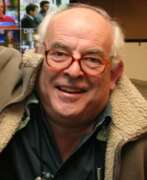

Ralph Idris Steadman is a British illustrator best known for his collaboration and friendship with the American writer Hunter S. Thompson. Steadman is renowned for his political and social caricatures, cartoons and picture books. As well as writing and illustrating his own books and Thompson's, Steadman has worked with writers including Ted Hughes, Adrian Mitchell and Brian Patten, and also illustrated editions of Alice in Wonderland, Treasure Island, Animal Farm, the English translation of Flann O'Brien's Gaelic-language classic The Poor Mouth, and most recently, Fahrenheit 451. Steadman has drawn album covers for numerous music artists, including the Who, Exodus, Frank Zappa and Ambrosia, and the lead banner for the gonzo journalism website GonzoToday.com.
